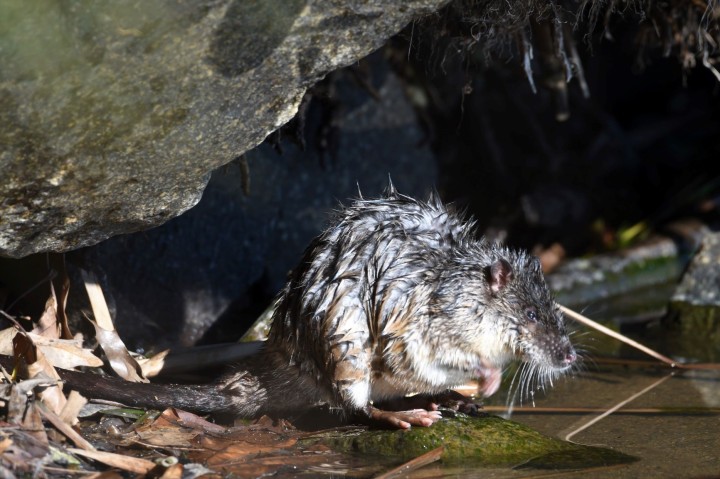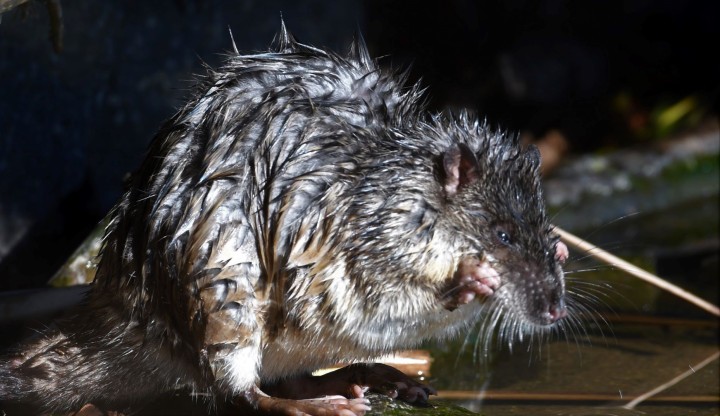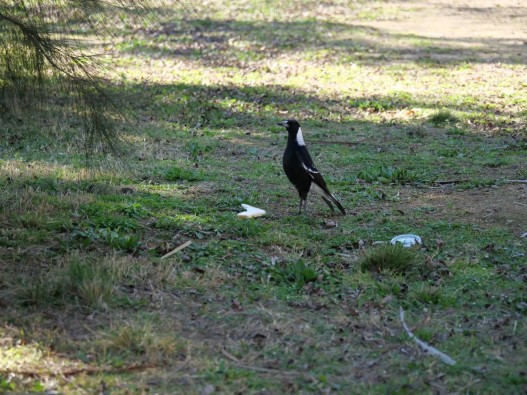Rakali (Hydromys chrysogaster) — not your average rodent.
Super soft and waterproof.
Golden belly water rat twitches
his whiskers and preens.
Rakali, top predator of the lake.


Birds are nervous.
Rakali is in their presence.
They keep their distance from
Rakali, top predator of the lake.

Magpie wants lunch.
Doesn’t want to be lunch.
Retreats. Respect for
Rakali, top predator of the lake.

Rakali bravely sashays ashore.
A slice of bread will do nicely.
Bread and bird are gone. Disappointed.
Rakali, top predator of the lake.

Known to enjoy a chip or two.
But no vegetarian, no vegan.
He likes his meat and will not share.
Rakali, top predator of the lake.
Poor bird, poor bird, poor bird.


Hydromys chrysogaster is native to Australia and Papua New Guinea. It is a vital part of Australia’s ecosystem, keeping waterways clean in much the same way as otters do in other parts of the world. European settlers/colonisers once considered water rats a pest and a carrier of disease, so culled many. They also hunted them for their beautiful fur coats. It is notable that where rakali are present, brown and black rat numbers are reduced. They are now protected.
I have known of rakalis presence in our local waterways for some time. However, like the birds, I have kept my distance. Funnily enough, once I had decided I would like to photograph some, I could not seem to find any. So my True Love and I were excited when we finally had our chance. I noticed a magpie peering towards the lake and my suspicions were immediately confirmed. Here was my chance. However, I had to hold my nerve when the rakali started running toward me. I felt the power of my camera offering me protection from my own irrational fears.
I’ve included a couple of entertaining videos for those wishing to know more. Videos may not be accessible to international readers.
Are they pretty?
Kind Regards.
Tracy.
I’m curling my toes just reading this. Great photos!
LikeLiked by 1 person
Thanks Heather. I tried to write it as a poem (or picture book story) for children. I didn’t want to scare my adult readers too much. My son, who took the last photo on his phone, thought the kids would love how it was a little gruesome.
LikeLiked by 4 people
Children would love it! What a wonderful idea to write/photograph a book with your son!
LikeLike
Lol, I’m not doing a book. Just having fun.
LikeLiked by 1 person
lol! Too bad my great nephews would have loved it!
LikeLiked by 1 person
You succeeded admirably! My two young nephews would love it.
LikeLiked by 1 person
Thank you, Liz. I might have to write some more stories then.
LikeLiked by 1 person
Yes, please do! They will have a receptive audience.
LikeLiked by 1 person
The WWF(World Wildlife Federation) is one of many groups working to save the Rakali, or Australia Water Rat. Ninety-nine percent of human genes are shared with these rodents. Rats have about 300 genes that we do not share. Thank you Tracy, I’m smitten with your water rat photographs. ‘’ Wind in the Willows”’ with Rat, Mole, Toad and the river bank come to mind. Sixty-six million years ago Rat like mammals survived the great asteroid extinction but dinosaurs did not!
LikeLiked by 3 people
I am so pleased you like them, Sid. If the rakali can survive our use of illegal fishing traps, hopefully they will prevail long after we are all gone. I tried to write my post as a (small and big) kids story, so I am thrilled that it reminded you of “Wind in the Willows”.
LikeLiked by 1 person
Thanks for sharing this, Tracy. I must admit, till I read your post, I knew nothing about Rakali!
LikeLiked by 2 people
My pleasure, Punam. You would not be alone there. 🙂
LikeLiked by 1 person
Nor did I!
LikeLiked by 2 people
Lovely to see Harry Butler 😀
LikeLiked by 1 person
A good blast from the past, Brian. 🙂
LikeLiked by 1 person
My brain says “rakali good” — my instincts say “ugh, run.”
LikeLiked by 3 people
I had the same reaction, Su. 🙂
LikeLiked by 1 person
Those are great photos! I’ve never seen a real live Rakali before, but they look interesting. Not sure I’d be brave enough to get up close, but that’s just because rats in general sort of scare me. Which is of course, my issue and not theirs!
LikeLiked by 2 people
My problem too, Ann. It helps to a telephoto lens. 🙂 Still, it got a bit close.
LikeLiked by 1 person
They might not be pretty in the traditional way of thinking, but they sure are fascinating. Thanks for introducing me to a new kind of Australian animal, Tracy!
LikeLiked by 2 people
My pleasure, Dries.
LikeLiked by 1 person
Powerful!
LikeLiked by 1 person
Thank you! And thanks so much for stopping by. Kind Regards. Tracy.
LikeLiked by 1 person
You’re welcome
LikeLiked by 1 person
We saw one of these when we lived by the river on our olive farm but our view was a distant one. It’s great see some closeups and to read your enlightening info. Thanks, Tracy.
LikeLiked by 1 person
Glad you liked it, Jane. You’ll probably see them everywhere now. 🙂
LikeLike
I think they definitely are, Tracy! That and fascinating! We used to have a fairly large community of rats in a local park where I learned to appreciate their looks as they were rather cute to watch. And as long as they stay outside of the house I don’t mind them at all.😊
Loved the poem you wrote about this predator of the lake, and to have learned something new again. 😄
LikeLiked by 1 person
Thank you, Sarah. I have found myself being a lot more tolerant of the creepy crawlies since starting my blog. 🙂
LikeLiked by 1 person
I’ve noticed the same, though there are limits to my tolerance which include eigth-legged monsters… 😉
LikeLiked by 2 people
What a clever poem you wrote, reminding us to watch carefully and learn about the world in all its aspects. I think I’d be running back to a safe space were I ever to encounter one of these rakali. He’s formidable, but me? Not so much.
LikeLiked by 1 person
Thanks Sharon. I’ve grown to love the rakali, although I must admit I was a little squeamish until I learnt more about them.
LikeLiked by 1 person
Such a fantastic and informative post. Thanks for sharing your photos too. I had never seen a rakali before. Is this critter big? It looks like it is about three times the size of a regular rat, right? A little bit scary but cute mustaches. Love the way you have presented the information. Creative and yes, that makes it easier to read.
LikeLiked by 2 people
Thanks Dominique. Yep, that is about the size of it. It is cheeky and a bit fierce.
LikeLiked by 1 person
This is great Tracy! They do look quite fearsome beasties!
LikeLiked by 1 person
Just a little, but in a good way. 🙂
LikeLiked by 1 person